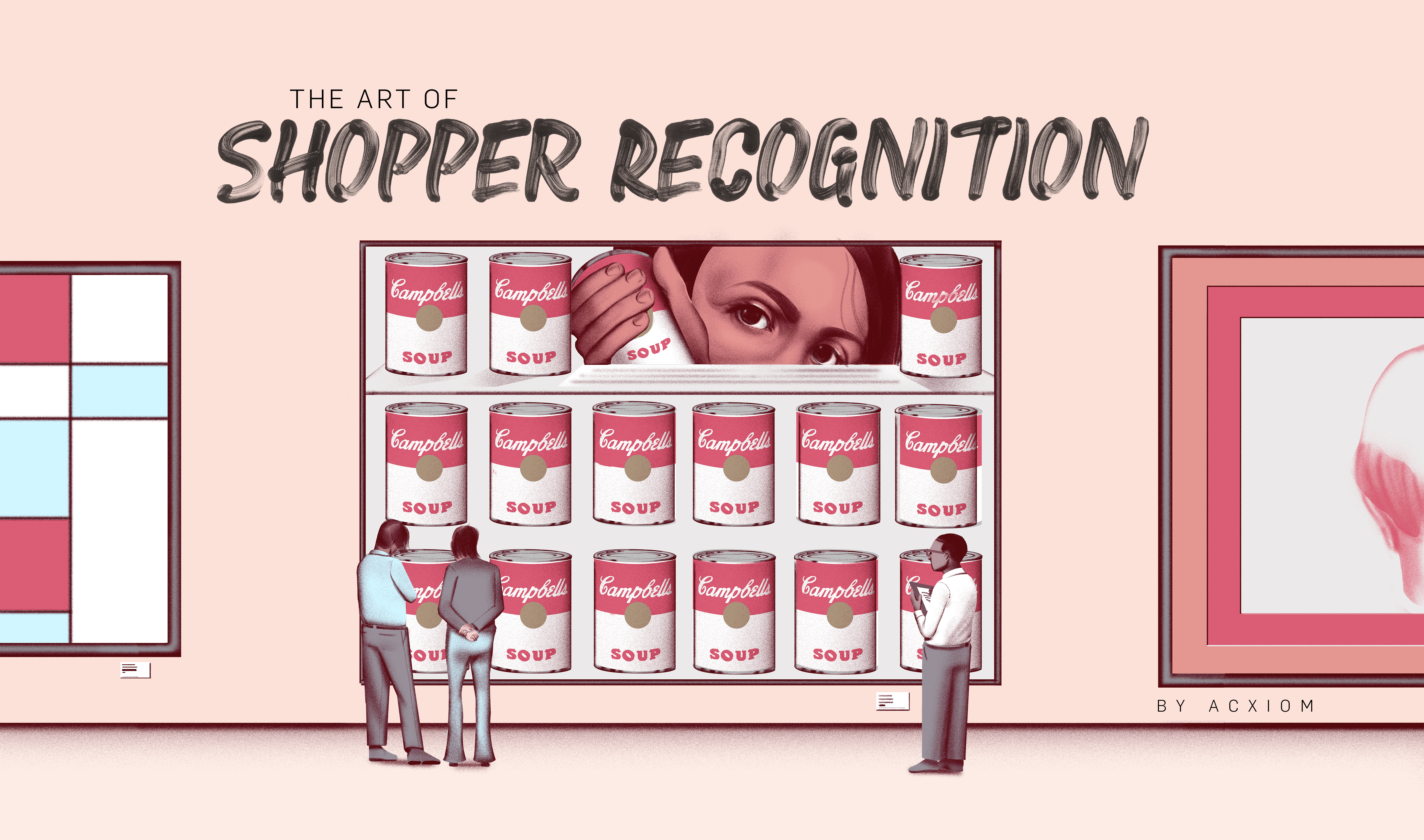




Your shoppers aren’t clicks and likes and dollars—they’re people.
They go to work or go to school or care for their kids or parents. (And sometimes all three.) They eat Indian or Italian or American food. They watch classic movies or sci-fi or game shows. And they like weird things like stinky cheese and chartreuse shoes and 45-minute YouTube videos of people organizing their spice drawer.
Shoppers expect the brands they do business with to understand these situations, preferences, needs and desires in order to offer them beautifully personalized experiences. In fact, 76% of shoppers are frustrated when this doesn’t happen, according to McKinsey research. Yet, many retailers see their shoppers as stick figures drawn with demographics rather than as the unique portraits they are.
Enriching your retail shopper data—and analyzing it for new insights—not only helps you optimize the customer experience, but it also benefits your brand. Brands that know their shoppers enjoy a 500% improvement in MROI, a 10% to 25% lift in sales and 40% higher conversion rates, according to McKinsey.
People who have a positive experience will spend 140% more than those who had a poor past experience. As a bonus, happy shoppers will also refer people to your brand, lowering your costs of acquisition. (Think of it as a BOGO sale: You pay to attract one shopper and get the second one for free.)
However, many retailers face one of two problems:
Not enough data. Seventy-five percent of transactions take place in stores where little may be known beyond what was purchased and the payment method used. As a result, transactional data alone is often not rich enough to let retailers recognize who the person is or what they need to know to connect with the shopper in a relevant way.
Not the right data. It can be challenging to understand your shopper only with information from your POS. Transaction data is important. But if you want to know the person, not just the transaction, you need descriptive data about the person, too.
So, how can retail brands learn enough about their shoppers to create the personalized experiences they crave? By leveraging the first-party data they already have, enriching it with third-party data, and then using the combined information to make an emotional connection to the individuals behind the transactions.

Your shoppers aren’t clicks and likes and dollars—they’re people.
They go to work or go to school or care for their kids or parents. (And sometimes all three.) They eat Indian or Italian or American food. They watch classic movies or sci-fi or game shows. And they like weird things like stinky cheese and chartreuse shoes and 45-minute YouTube videos of people organizing their spice drawer.
Shoppers expect the brands they do business with to understand these situations, preferences, needs and desires in order to offer them beautifully personalized experiences; in fact, 76% of shoppers are frustrated when this doesn’t happen, according to McKinsey research. Yet, many retailers see their shoppers as stick figures drawn with demographics rather than as the unique portraits they are.
Enriching your retail shopper data—and analyzing it for new insights—not only helps you optimize the customer experience, but it also benefits your brand. Brands that know their shoppers enjoy a 500% improvement in MROI, a 10% to 25% lift in sales and 40% higher conversion rates, according to McKinsey.
People who have a positive experience will spend 140% more than those who had a poor past experience. As a bonus, happy shoppers will also refer people to your brand, lowering your costs of acquisition. (Think of it as a BOGO sale: You pay to attract one shopper and get the second one for free.)
However, many retailers face one of two problems:
Not enough data. Seventy-five percent of transactions take place in stores where little may be known beyond what was purchased and the payment method used. As a result, transactional data alone is often not rich enough to let retailers recognize who the person is or what they need to know to connect with the shopper in a relevant way.
Not the right data. It can be challenging to understand your shopper only with information from your POS. Transaction data is important. But if you want to know the person, not just the transaction, you need descriptive data about the person, too.
So, how can retail brands learn enough about their shoppers to create the personalized experiences they crave? By leveraging the first-party data they already have, enriching it with third-party data, and then using the combined information to make an emotional connection to the individuals behind the transactions.



When a shopper makes a purchase from your business, you typically have a very fuzzy view of who they are. All you know at this point is that someone out there wanted product X. You don't yet understand who the shopper is or why they needed the item.
Transactional data—such as the timing of visits, category sales and payment methods—can help sharpen up the blurred edges of your shopper portrait. Much of this information is automatically collected by your POS, and cashiers might ask for more details as the shopper is checking out. Then you can piece these data points together to unearth even more insights. For example:
Purchase data can offer up clues into the lives of your customers. People who buy diapers every week are likely to be parents, shoppers who purchase yoga mats and aromatherapy mists may be stressed out, and people who buy both reading glasses and jigsaw puzzles could be seniors.
Payment methods tell you more about your shoppers than you might expect. Research from Rockbridge shows that the mobile payment users in your shopper base, for instance, are significantly more likely to be under 35 years old than 35-plus. And according to the PYMNTS.com report "Apple Pay at Seven," users of Apple Pay tend to be high earners who live in urban centers.
ZIP codes, which some retailers ask for at the register, reveal the demographics of your shopper base. Research data may show, say, that shoppers in a particular zone have an average annual income of $45,000, a high school education and a family size of 3.5.
Aggregated transactional data like this can start bringing your shoppers into focus. But because you don't know their identities, it won’t be the only tool to help you make a true connection with the real, live people in your customer base.




When a shopper makes a purchase from your business, you typically have a very fuzzy view of who they are. All you know at this point is that someone out there wanted product X. You don't yet understand who the shopper is or why they needed the item.
Transactional data—such as the timing of visits, category sales and payment methods—can help sharpen up the blurred edges of your shopper portrait. Much of this information is automatically collected by your POS, and cashiers might ask for more details as the shopper is checking out. Then you can piece these data points together to unearth even more insights. For example:
Purchase data can offer up clues into the lives of your customers. People who buy diapers every week are likely to be parents, shoppers who purchase yoga mats and aromatherapy mists may be stressed out, and people who buy both reading glasses and jigsaw puzzles could be seniors.

Payment methods tell you more about your shoppers than you might expect. Research from Rockbridge shows that the mobile payment users in your shopper base, for instance, are significantly more likely to be under 35 years old than 35-plus. And according to the PYMNTS.com report "Apple Pay at Seven," users of Apple Pay tend to be high earners who live in urban centers.
ZIP codes, which some retailers ask for at the register, reveal the demographics of your shopper base. Research data may show, say, that shoppers in a particular zone have an average annual income of $45,000, a high school education and a family size of 3.5.
Aggregated transactional data like this can start bringing your shoppers into focus. But because you don't know their identities, it won’t be the only tool to help you make a true connection with the real, live people in your customer base.



To get to the next stage of focus, you need to be able to identify each shopper—which you can’t do with transactional data alone. The challenge is that when someone buys a pair of socks at one of your stores, they’re not always interested in handing over their name and contact information. Even asking for their ZIP code can be a stretch.
So, one way to gather the identifying data you need is through the "reverse append" feature in a shopper recognition solution. Reverse append connects a customer name, email or postal address when the shopper provides another of these data points at checkout, letting you gather important data without inconveniencing the shopper.
Another way to collect data that helps you connect the shopper to the sale is to incentivize your customers to give it to you. You’ve probably experienced this yourself: You’re at the supermarket, your local coffee shop or a big box retailer, and when you reach the register you whip a loyalty card out of your wallet. At an online store, you might enter your email address or log in to the site. These programs let you score discounts, bonuses and free shipping in exchange for your name and contact details.
More sophisticated loyalty programs can even foster trust—and repeat purchases—by using purchase data to make personalized offers rather than simply sending out blanket discounts. For example, instead of getting a 50% off deal at the local café, you might receive a coupon for a free vanilla-cardamom latte to tempt your (data-proven) sweet tooth.
The problem is that loyalty programs don’t keep shoppers as, well, loyal as they used to, according to McKinsey. During the Covid-19 pandemic, when an item went out of stock, only 13% of consumers waited for it to become available again. Thirty-nine percent switched products, and 32% switched retailers altogether. Getting a crisp view of these shoppers is like trying to hit a (literally) moving target.
Not only that, no loyalty program will capture 100% of shoppers; even the best have only a 20% to 60% participation rate, according to Acxiom data.
So, while loyalty programs can help you match shoppers to transactions and create personalized offers, they’re not enough on their own to generate the crystal-clear picture you’re aiming for. That’s why the final step of putting your shopper in focus is understanding context through third-party data.



To get to the next stage of focus, you need to be able to identify each shopper—which you can’t do with transactional data alone. The challenge is that when someone buys a pair of socks at one of your stores, they’re not always interested in handing over their name and contact information. Even asking for their ZIP code can be a stretch.
So, one way to gather the identifying data you need is through the "reverse append" feature in a shopper recognition solution. Reverse append connects a customer name, email or postal address when the shopper provides another of these data points at checkout, letting you gather important data without inconveniencing the shopper.
Another way to collect data that helps you connect the shopper to the sale is to incentivize your customers to give it to you. You’ve probably experienced this yourself: You’re at the supermarket, your local coffee shop or a big box retailer, and when you reach the register you whip a loyalty card out of your wallet. At an online store, you might enter your email address or log in to the site. These programs let you score discounts, bonuses and free shipping in exchange for your name and contact details.
More sophisticated loyalty programs can even foster trust—and repeat purchases—by using purchase data to make personalized offers rather than simply sending out blanket discounts. For example, instead of getting a 50% off deal at the local café, you might receive a coupon for a free vanilla-cardamom latte to tempt your (data-proven) sweet tooth.

The problem is that loyalty programs don’t keep shoppers as, well, loyal as they used to, according to McKinsey. During the Covid-19 pandemic, when an item went out of stock, only 13% of consumers waited for it to become available again. Thirty-nine percent switched products, and 32% switched retailers altogether. Getting a crisp view of these shoppers is like trying to hit a (literally) moving target.
Not only that, no loyalty program will capture 100% of shoppers; even the best have only a 20% to 60% participation rate, according to Acxiom data.
So, while loyalty programs can help you match shoppers to transactions and create personalized offers, they’re not enough on their own to generate the crystal-clear picture you’re aiming for. That’s why the final step of putting your shopper in focus is understanding context through third-party data.



You can now connect your transactional data with actual people, helping you create a sharper picture of your shoppers. But trying to understand shoppers based only on these data points is like trying to understand a Seurat painting by looking at just one dot. It’s only when you step back and take in the entire painting that the real image reveals itself.
In a piece of artwork, you may glean meaningful clues from the background, the lighting and colors, and the subject's expression. In retail, meaningful clues come from a different kind of contextual data: information like social media, the weather, the news and market changes. Contextual data helps solve two major challenges when working with transactional data.
Transactional data alone can mislead you. When you rely only on transactional data to bring your shoppers into focus, you run the risk of assuming too much about them. This can cause you to miss the mark on delivering personalized experiences.
For example, you might assume that a shopper who purchases kids’ clothes is a parent and send them emails marketing the latest kids’ styles. But what if that shopper is actually a grandparent—a segment that tends to buy at tentpole events? You’re not only potentially turning them off by sending irrelevant ads, but you’re also losing out on the opportunity to send them a personalized message about your one-day holiday sale.
Not to mention, life—like painting—can be messy. The shopper who lives in a particular ZIP code may earn $45,000 per year and have two kids, as expected. Or she may be someone who earns $120,000 per year, has no kids, just got a job in a new city, and is living with relatives until she finds a place of her own. A millennial may hand over a wad of cash instead of paying through an app because he has a stack of bills from a recent Craigslist sale. And the person buying reading glasses and jigsaw puzzles might be a 19-year-old donating to a shelter and not a senior citizen.
Adding contextual data to transactional information helps you turn hunches and guesstimates about your shoppers into actual knowledge.
Transactional data is limited in time and place. Your transactional data only gives you a picture of the person at the exact point at which they interact with your brand—and individuals have full, rich lives that take place mainly outside of your stores. If you don't understand these lives away from your brand, you can miss out on opportunities to truly connect with your shoppers.
For example, say you're a kitchenware retailer. You might know that your shopper likes contemporary dinnerware, that he has an indoor herb garden and that he sometimes cooks with his kids.
But without understanding the context in which your shopper lives, you can't know his likes, dislikes, values, beliefs and attitudes. What are his health goals? Does he stick to comfort foods or is he an alimentary adventurer? Is he concerned with the environmental or ethical impact of factory farming? Is he an aspirational chef who dreams of creating three-course meals every night?
Analyzing contextual data lets you anticipate what your shoppers will want to purchase, so you can create meaningful and valuable experiences through your promotional offerings, messaging and brand interactions. After all, you would send different content to a shopper who likes to throw elegant dinner parties than to a home cook who's concerned with preventing heart disease.
That said, managing, enriching and understanding all of this shopper data is no easy task. While many retailers manage to extract good insights from their transactional data by piecing together various tools, for brands that want to bring their shoppers into even sharper focus, it can be worth partnering with a service provider to enrich your transactional data with third-party contextual data.
Shoppers who have a great experience with a brand will spend 140% more than those who had a poor past experience. The level of clarity you gain can help you create an emotional connection that leads to a picture-perfect customer experience, turning your shoppers from one-time purchasers into fans—and your brand's fans are the people who have a true effect on your bottom line.





You can now connect your transactional data with actual people, helping you create a sharper picture of your shoppers. But trying to understand shoppers based only on these data points is like trying to understand a Seurat painting by looking at just one dot. It’s only when you step back and take in the entire painting that the real image reveals itself.
In a piece of artwork, you may glean meaningful clues from the background, the lighting and colors, and the subject's expression. In retail, meaningful clues come from a different kind of contextual data: information like social media, the weather, the news and market changes. Contextual data helps solve two major challenges when working with transactional data.
Transactional data alone can mislead you. When you rely only on transactional data to bring your shoppers into focus, you run the risk of assuming too much about them. This can cause you to miss the mark on delivering personalized experiences.
For example, you might assume that a shopper who purchases kids’ clothes is a parent and send them emails marketing the latest kids’ styles. But what if that shopper is actually a grandparent—a segment that tends to buy at tentpole events? You’re not only potentially turning them off by sending irrelevant ads, but you’re also losing out on the opportunity to send them a personalized message about your one-day holiday sale.
Not to mention, life—like painting—can be messy. The shopper who lives in a particular ZIP code may earn $45,000 per year and have two kids, as expected. Or she may be someone who earns $120,000 per year, has no kids, just got a job in a new city, and is living with relatives until she finds a place of her own. A millennial may hand over a wad of cash instead of paying through an app because he has a stack of bills from a recent Craigslist sale. And the person buying reading glasses and jigsaw puzzles might be a 19-year-old donating to a shelter and not a senior citizen.

Adding contextual data to transactional information helps you turn hunches and guesstimates about your shoppers into actual knowledge.
Transactional data is limited in time and place. Your transactional data only gives you a picture of the person at the exact point at which they interact with your brand—and individuals have full, rich lives that take place mainly outside of your stores. If you don't understand these lives away from your brand, you can miss out on opportunities to truly connect with your shoppers.
For example, say you're a kitchenware retailer. You might know that your shopper likes contemporary dinnerware, that he has an indoor herb garden and that he sometimes cooks with his kids.
But without understanding the context in which your shopper lives, you can't know his likes, dislikes, values, beliefs and attitudes. What are his health goals? Does he stick to comfort foods or is he an alimentary adventurer? Is he concerned with the environmental or ethical impact of factory farming? Is he an aspirational chef who dreams of creating three-course meals every night?
Analyzing contextual data lets you anticipate what your shoppers will want to purchase, so you can create meaningful and valuable experiences through your promotional offerings, messaging and brand interactions. After all, you would send different content to a shopper who likes to throw elegant dinner parties than to a home cook who's concerned with preventing heart disease.
That said, managing, enriching and understanding all of this shopper data is no easy task. While many retailers manage to extract good insights from their transactional data by piecing together various tools, for brands that want to bring their shoppers into even sharper focus, it can be worth partnering with a service provider to enrich your transactional data with third-party contextual data.
Shoppers who have a great experience with a brand will spend 140% more than those who had a poor past experience. The level of clarity you gain can help you create an emotional connection that leads to a picture-perfect customer experience, turning your shoppers from one-time purchasers into fans—and your brand's fans are the people who have a true effect on your bottom line.


Acxiom provides data-driven solutions that enable the world’s best marketers to better understand their customers to create better experiences and business growth. A leader in customer data management, identity and the ethical use of data for more than 50 years, Acxiom now helps thousands of clients and partners around the globe work together to create millions of better customer experiences, every day. Acxiom also offers a full suite of strategy consulting, predictive and marketing analytics and marketing measurement offerings to support all facets of the data-driven prospect and customer journey. Acxiom helps brands evolve their data strategy, understand marketing impact and better know their prospects and customers and predict behaviors. Visit acxiom.com or email info@acxiom.com to get started.
Illustrations by Richard A. Chance


Acxiom provides data-driven solutions that enable the world’s best marketers to better understand their customers to create better experiences and business growth. A leader in customer data management, identity and the ethical use of data for more than 50 years, Acxiom now helps thousands of clients and partners around the globe work together to create millions of better customer experiences, every day. Acxiom also offers a full suite of strategy consulting, predictive and marketing analytics and marketing measurement offerings to support all facets of the data-driven prospect and customer journey. Acxiom helps brands evolve their data strategy, understand marketing impact and better know their prospects and customers and predict behaviors. Visit acxiom.com or email info@acxiom.com to get started.
Illustrations by Richard A. Chance

 Built with Shorthand
Built with Shorthand





